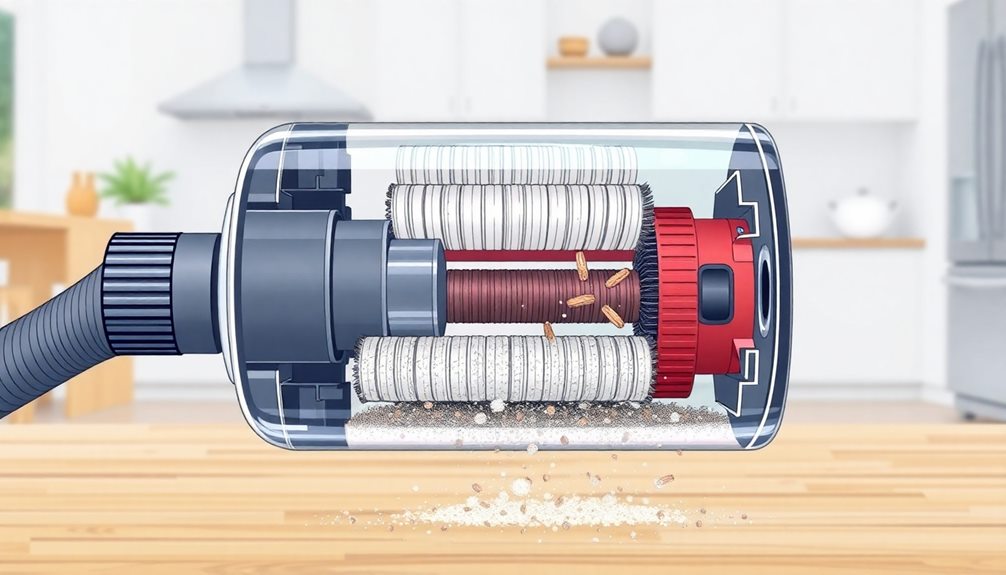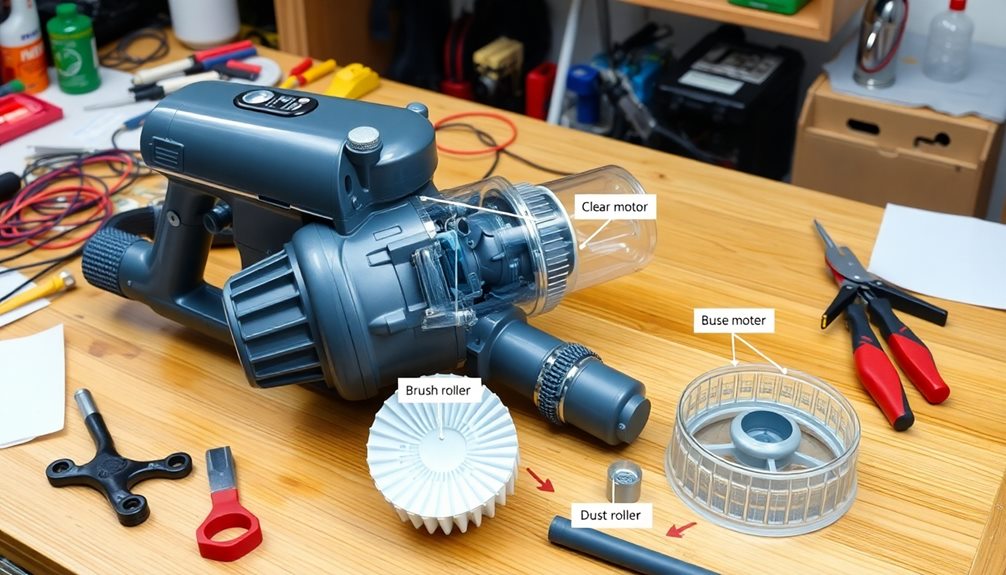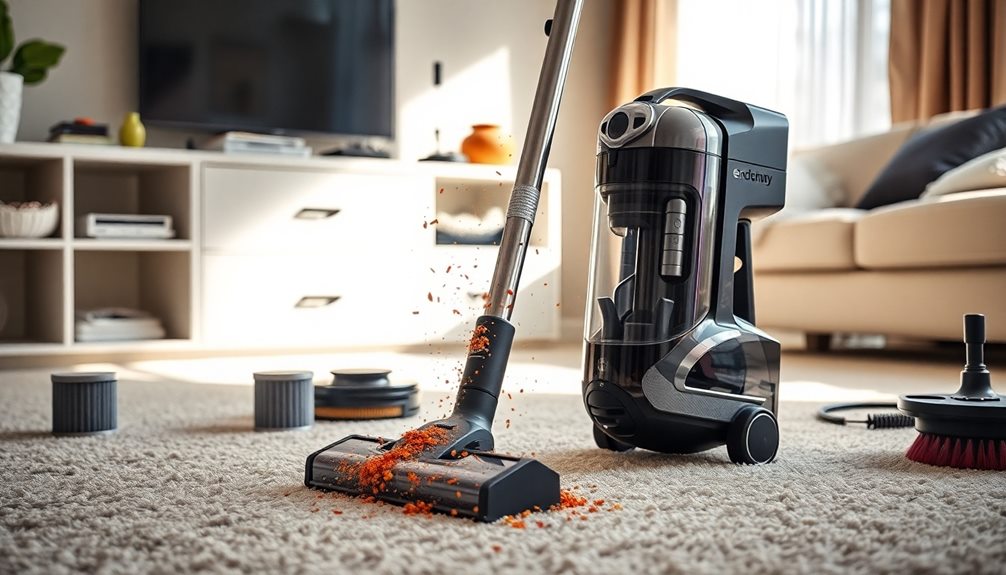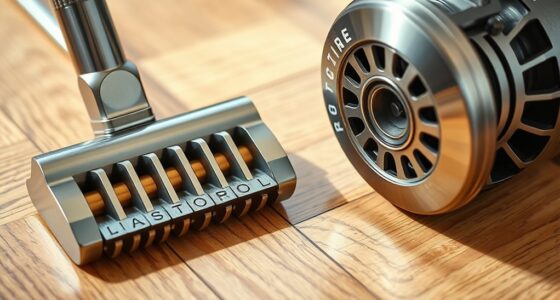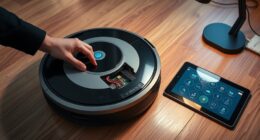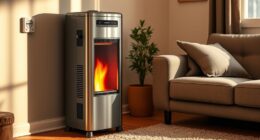Vacuum cleaners work by using an electric motor to spin a fan, creating suction that pulls dirt and debris into the machine. When you turn it on, the intake port draws in air, which carries the particles along with it. The fan's design reduces pressure inside, allowing atmospheric pressure to push dirt into a bag or container, where it's trapped. The brush roll, found in upright models, agitates carpet fibers for better dirt removal. By regular maintenance, like cleaning filters and bags, you can keep your vacuum performing efficiently. Stick around to discover more about their components and types!
Key Takeaways
- Vacuum cleaners create suction through an electric motor that spins a fan, generating airflow to pull in dirt and debris.
- The intake port allows dirt-laden air to enter the vacuum, while the porous bag or filter traps debris.
- Different types of vacuum cleaners, like upright and canister models, are designed for specific cleaning tasks and surfaces.
- Regular maintenance, such as cleaning filters and emptying dust containers, is essential for optimal performance and suction efficiency.
- Innovations like cyclone systems and robotic vacuums enhance suction power and offer convenience through autonomous cleaning capabilities.
Historical Development of Vacuum Cleaners
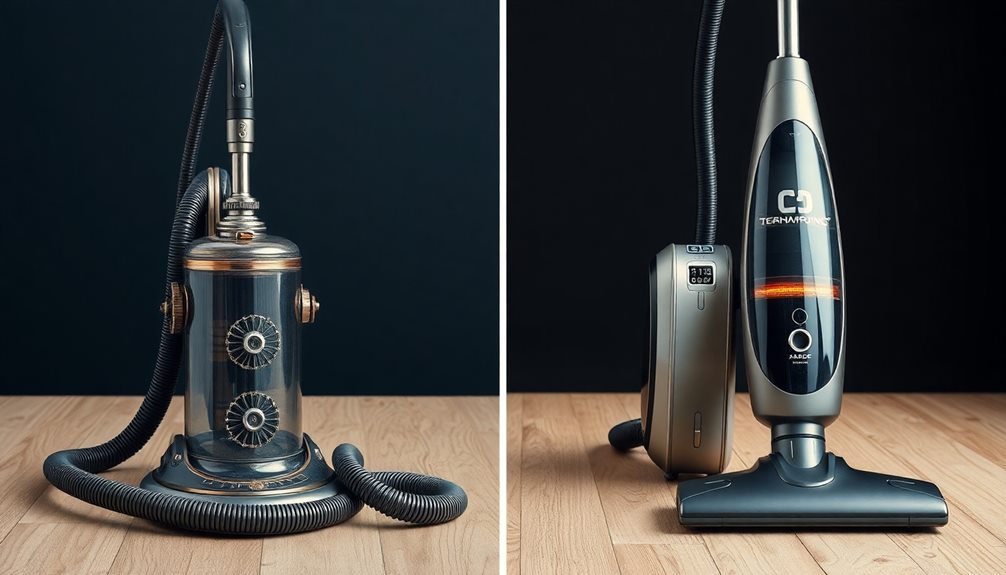
The historical development of vacuum cleaners showcases a fascinating evolution in cleaning technology. Vacuum cleaners originated in the mid-1800s with hand-operated bellows, marking the beginning of mechanical cleaning devices. These early models were bulky and required significant effort to operate, but they laid the groundwork for future innovations.
By the early 1900s, the first electric vacuum cleaners emerged, marketed as luxury items due to their high price and size. Over the last century, vacuum cleaners have transformed dramatically. They've evolved from heavy machines weighing up to 100 pounds to compact and efficient designs that fit seamlessly into your home.
Central vacuum systems have also gained popularity, featuring motorized fans and interconnected pipes that provide powerful suction power throughout your living space. Today's vacuum cleaners are indispensable household appliances, thanks to continuous innovations that streamline your cleaning processes.
Whether you prefer a lightweight upright or a sophisticated central system, the evolution of vacuum cleaners reflects a commitment to enhancing convenience and effectiveness in everyday cleaning tasks. You'll find that these advancements not only save you time but also improve the overall cleanliness of your home.
Basic Components of Vacuum Cleaners
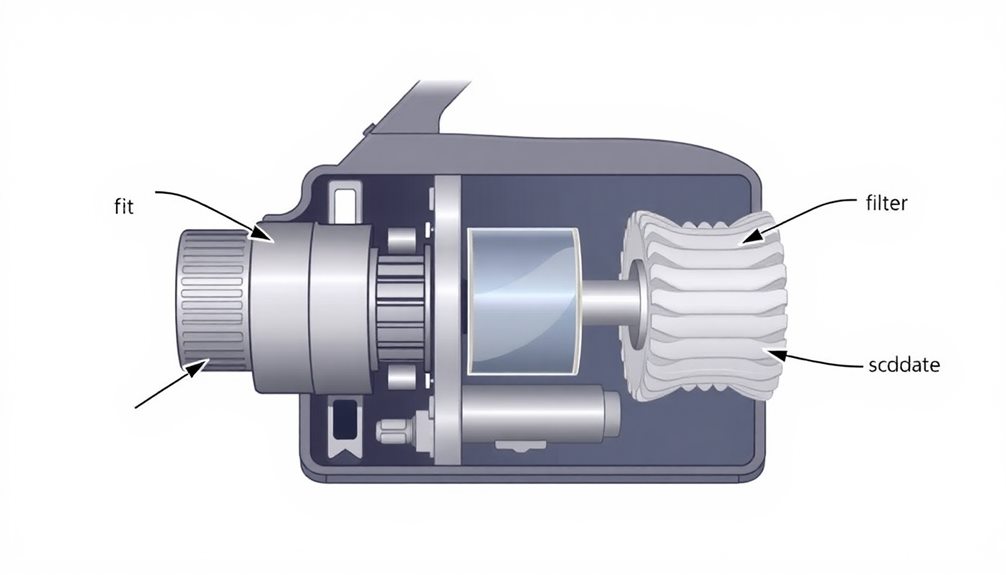
Understanding how vacuum cleaners work starts with recognizing their basic components. The fundamental components include the intake port, electric motor, fan, porous bag, brush roll, and housing. Together, they create suction to collect debris from your floors.
Some models are specifically designed for optimal performance in removing allergens, making them ideal for allergy sufferers and households with pets, as highlighted in the best vacuums for dust removal in 2024.
When you turn on the vacuum, the electric motor powers the fan, generating airflow toward the exhaust port. This process creates a pressure drop, allowing ambient air to enter through the intake port. As air and debris are pulled in, the rotating fan mimics the action of drinking through a straw, facilitating the removal of dirt.
The brush roll plays a vital role, especially in upright vacuums. It agitates carpet fibers, loosening dirt and debris for easier suction.
Once lifted, the dirt-laden air travels through the porous bag or container, where the filtration system filters out the debris, preventing it from being released back into your environment.
Types of Vacuum Cleaners

When you're looking for the right vacuum cleaner, understanding the different types can make all the difference.
Each design—like upright, canister, cordless, robotic, and wet/dry—has unique features tailored to specific cleaning needs.
Types of Vacuum Designs
Versatility in vacuum cleaner designs means there's an option tailored to nearly every cleaning need.
When considering the types of vacuum cleaners, you'll find upright models are excellent for deep cleaning carpets, thanks to their powerful motors and rotating brushes.
If you need flexibility, canister vacuums are a great choice, allowing you to easily maneuver between various surfaces and tight spaces.
For those who prioritize convenience, cordless vacuums offer the freedom to clean without being tethered to a power outlet.
However, keep in mind that they may have less suction power compared to corded options.
If you're looking for a hands-off cleaning experience, robotic vacuums use advanced sensors and smart technology to autonomously navigate your home, making them perfect for low-maintenance cleaning.
For heavy-duty cleaning tasks, wet/dry vacuums excel at handling both liquid and solid debris, making them incredibly versatile.
Each type of vacuum cleaner has its strengths, so think about your specific cleaning needs and preferences when making a choice.
With the right design, you can tackle any mess with ease and efficiency.
Features of Each Type
Each type of vacuum cleaner comes with unique features tailored to different cleaning needs.
Upright vacuums are designed for efficient carpet cleaning, utilizing a mechanism with rotating brushes that lift dirt. Many of these models also have a self-propelled option, making maneuverability a breeze.
Top rated vacuums have been tested for efficiency on various surfaces, ensuring effective performance.
On the other hand, canister vacuums offer versatility, with a separate canister and hose that make them perfect for hardwood floors and tight spaces.
If you're looking for convenience, cordless vacuums provide flexibility for quick cleanups. However, keep in mind they might've less suction power and limited battery life compared to traditional models.
Robotic vacuums are another innovative option; equipped with smart technology and sensors, they autonomously navigate around furniture, cleaning floors with minimal input from you.
For heavy-duty tasks, wet/dry vacuums shine. They can handle both liquid and solid debris, featuring a unique collection system that protects filters from liquid damage.
Many of these vacuums come with various attachments, so you can tackle different cleaning challenges with ease.
Each type has its own strengths, ensuring you find the perfect fit for your cleaning needs.
Choosing the Right Vacuum
Finding the right vacuum cleaner for your home can make all the difference in your cleaning routine. With different types of vacuum available, you'll want to take into account your specific needs.
For powerful suction on carpets, upright vacuums feature rotating brushes that effectively lift dirt and debris. If versatility is key, canister vacuums are compact and great for reaching tight spaces, thanks to their detachable hose and wand.
If you need portability, cordless vacuums are perfect for quick clean-ups, though they might offer less suction compared to corded models. For a hands-off approach, robotic vacuums use smart technology to navigate your home autonomously, maintaining cleanliness without your effort.
Bagless models are also worth taking into account, as they eliminate the need for traditional bags and use clear containers that let you see when it's time to empty them.
Many vacuums also come with HEPA filters to guarantee clean air passes through, making them ideal for allergy sufferers. Don't forget about vacuum attachments, which can enhance your cleaning experience by allowing you to tackle various surfaces with greater suction.
Choose wisely to find the vacuum that suits your lifestyle best!
How Suction Works

Suction is the heart of a vacuum cleaner's functionality, driving its ability to effectively remove dirt and debris from surfaces. It all begins with the electric motor that spins a fan, creating strong suction that pulls air and debris through the intake tube.
As the fan's angled blades rotate, they generate airflow, reducing the pressure inside the vacuum. This difference in pressure allows atmospheric pressure to push the dirt-laden air into the machine.
The design of the intake port plays a significant role in suction power; narrower openings increase airspeed, enhancing suction strength. As the air flows back through the vacuum, the fan's constant motion helps carry dirt and debris, allowing them to float within the airflow.
Once the air and debris enter the vacuum, they pass through a porous bag or filter, trapping the debris while clean air is expelled through the exhaust port.
This process not only guarantees effective cleaning but also maintains indoor air quality by preventing dust and allergens from recirculating. Understanding how suction works helps you appreciate the efficiency of your vacuum cleaner.
Maintenance and Care Tips
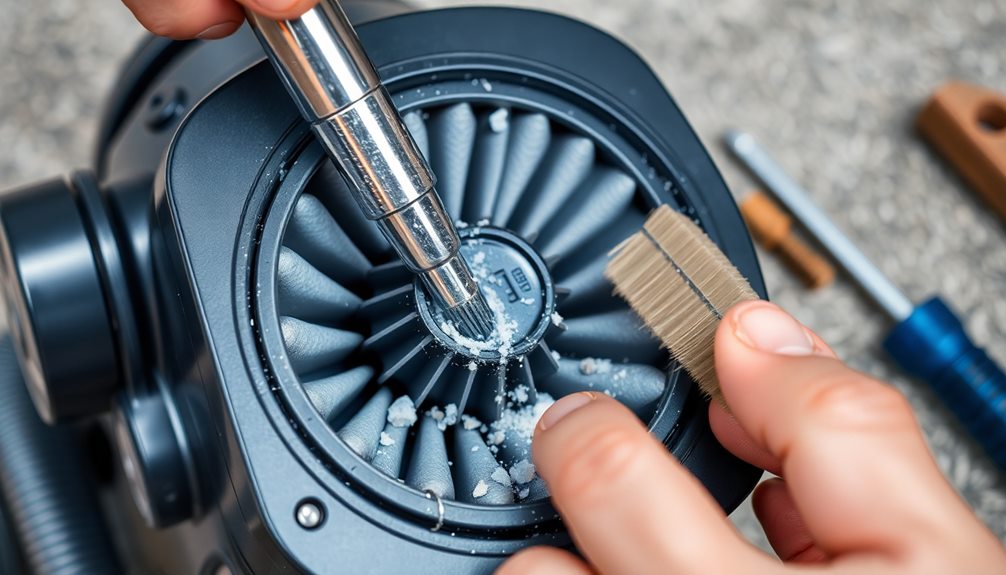
To keep your vacuum cleaner running efficiently, it's essential to follow a regular maintenance routine. Start by regularly cleaning or replacing the filters; dirty filters can clog your vacuum and greatly reduce suction efficiency. Remarkably, many top-rated vacuums feature anti-allergen technology, which helps improve air quality while you clean.
To maintain peak suction power, empty the dust container or replace the vacuum bag when it's about two-thirds full. This prevents overheating and guarantees your vacuum operates at its best.
Next, inspect and clean the brush roll frequently. Hair and debris can hinder its performance and strain the motor. Also, check for blockages in hoses and attachments regularly, as obstructions can disrupt airflow and decrease your vacuum's cleaning effectiveness.
Don't forget to follow the manufacturer's maintenance guidelines. This may include lubricating moving parts and checking for wear on belts and wheels. By keeping an eye on these components, you can enhance the longevity and dependable operation of your vacuum cleaner.
Incorporating these maintenance tips into your routine won't only improve the performance of your vacuum but also guarantee it lasts longer, saving you money in the long run.
Innovations in Vacuum Technology

Revolutionizing the way we clean, innovations in vacuum technology have transformed household chores into more efficient and convenient tasks. One standout development is the cyclone vacuum system, pioneered by James Dyson in the 1980s, which uses centrifugal force to maintain powerful suction without the need for bags. This technology allows you to enjoy hassle-free cleaning.
You might also appreciate the rise of robot vacuums equipped with advanced sensors and navigation systems. These smart vacuum systems autonomously navigate your home, making cleaning a hands-off experience. With IoT capabilities, you can control and schedule cleanings directly from your smartphone, giving you even more convenience.
Additionally, modern vacuums have introduced self-cleaning filters and maintenance alerts, which enhance user experience by ensuring peak performance over time.
The advancements in battery technology have resulted in cordless vacuum models that not only provide longer run times but also powerful suction, making them practical alternatives to traditional plug-in vacuums.
These innovations in vacuum technology truly elevate your cleaning game, combining efficiency and ease for a cleaner home.
Frequently Asked Questions
How Does a Vacuum Cleaner Really Work?
You might think vacuum cleaners just suck up dirt, but they actually create negative pressure. An electric motor spins a fan, drawing in dirt-laden air, trapping debris while expelling clean air through filters. It's efficient!
How Does a Vacuum Cleaner Work Step by Step?
Imagine a powerful whirlwind in your hands. To understand how a vacuum cleaner works step by step, you'll see it spin, create suction, pull in dirt, filter out particles, and leave your space sparkling clean.
How Does a Vacuum System Work?
A vacuum system creates suction by spinning a fan with an electric motor, lowering air pressure inside. This pressure difference pulls in dirt and debris, which gets trapped in a dust collection bag or container.
What Is the Working Principle of a Vacuum Cleaner?
You might think a vacuum cleaner just sucks up dirt, but it actually creates a low-pressure zone. This negative pressure pulls debris in, trapping it while clean air escapes, ensuring your space stays spotless.
Conclusion
In a world where dust bunnies lurk in every corner, understanding how vacuum cleaners work can feel like revealing a hidden treasure. By grasping the history, components, and mechanics behind these handy devices, you're not just cleaning—you're wielding a powerful tool against grime. So, as you set off on your next cleaning adventure, remember that with a little maintenance and care, you can keep your vacuum running like new, ready to tackle even the toughest messes.
